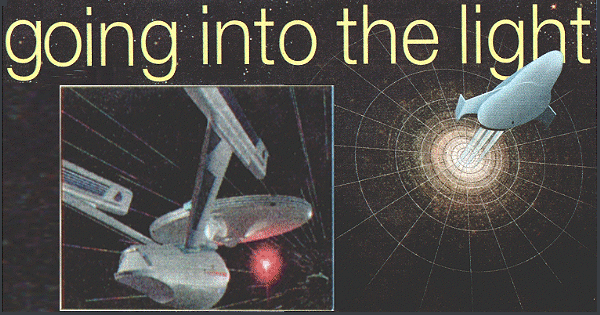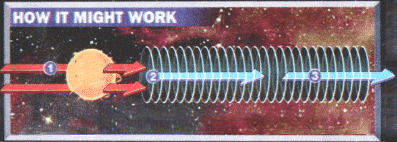
If there is a Holy Grail of space exploration, then achieving interstellar
travel would be it. Unfortunately, the nearest star to our Sun is Proxima
Centauri - lying a mere 4.22 light years away- and to get to that in the
Space Shuttle, for example, would take a pretty daunting 160,000 years. So,
if we want to reach even the nearest stars within a human lifetime we will
require a radically different form of propulsion.
Science-fiction writers have had the solution for decades - faster than light
travel, or warp speed as they call it in Star Trek. After all, if you can
travel near to, or faster than, the speed of light it will take only a few
years to reach your destination. Problems arise, however, when you try to
do it in the real world after all, light travels at more than 1billion kph.
 |
1. A star travels through space
at enormous speed
2. If the star is moving faster than 57.7 per cent
of the speed of light it will start to repel other masses lying in its path
3. This action creates an 'anti-gravity'corridor.
Without gravity acting upon it,a craft placed in this corridor would fall
weightlessly - requiring relatively little thrust to reach near-light
speeds |
It has been calculated that to propel a one-tonne payload to 90 per cent
of the speed of light would require the energy produced by 30billion tonnes
of TNT. Imagine the effect that such rapid acceleration would have on our
feeble human bodies.
But there may be a solution - at least that's what physicist Dr Franklin
Felber wants us to
believe. On Tuesday, he presented his solution to Einstein's 90-year- old
gravitational field equation. The solution is the first to account for masses
moving near the speed of light and seems to solve the two greatest challenges
facing near-light- speed travel - identifying an energy source capable of
producing the acceleration and not killing the passengers while doing so.
Dr Felber proposes achieving near- light-speed travel, not via conventional
propulsion, but by hitching a ride on a star.
'Dr Felber's research will revolutionise space flight,' said Dr Eric Davis
of the Institute for Advanced Studies at Austin, Texas. 'He taken us a huge
step forward in making near- speed-of-light space travel safe, possible and
much less costly.' His research shows that any 'mass, such as a star, moving
at more than 57.7 per cent of the speed of light will gravitationally repel
other masses lying in front of it.
This would form a narrow '
anti
gravity beam' in front of it - the loser the star is travelling to the
speed of light the more powerful the beam.
He calculates that you could use that repulsion to provide the enormous energy
needed to accelerate massive payloads to near the speed of light, by drawing
energy from the anti-gravity force of the much more massive star. But what
about the massive stresses on the human body? Well, under conventional
acceleration it is the g forces (gravitational forces) exerted that cause
damage - since the craft will be travelling in an anti-gravity environment,
gravitational forces will not be an issue. At least, that is the theory.
'Based on this research, I expect a mission to accelerate a payload to a
"good fraction of light speed" will be launched before the end of the century,'
said Dr Felber.
[The Metro Feb16,2006] |
